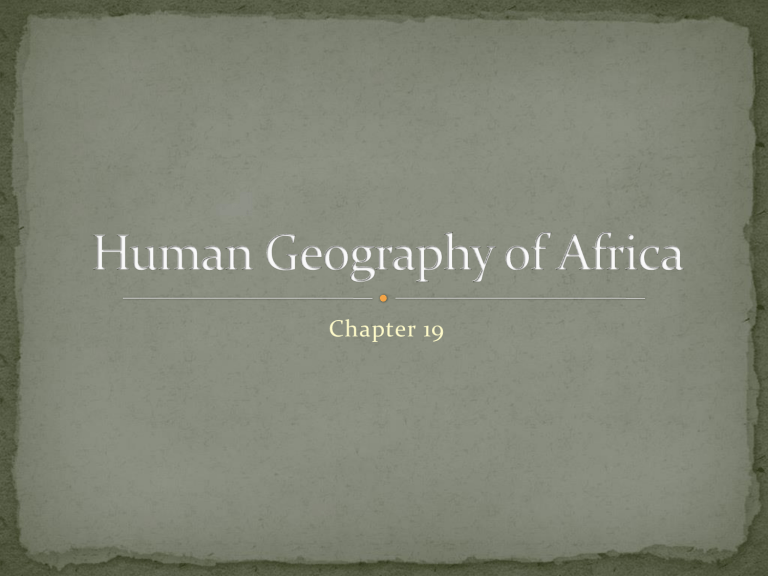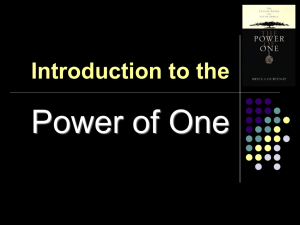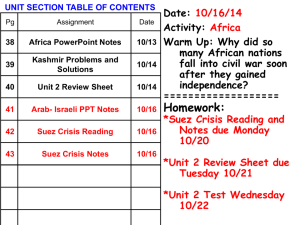Human Geography of Africa

Chapter 19
“Cradle of Humanity”
Olduvai Gorge – northern Tanzania
Most continuous known record of humanity
Gorge has yielded fossils from 65 individual hominids, or humans
Louis and Mary Leakey
Discovery of “Lucy”
Ethiopia: A Successful Resistance
Successfully resisted Europeans
Menelik II – played Italians, French, and British against each other
1896 – Battle of Adowa – Ethiopian forces successfully defeated the
Italians and kept their nation independent
1970s – most of East Africa had regained its independence from Europe
Internal disputes and civil wars
Ex: colonialism inflamed the peoples of Rwanda and helped to cause a bloody conflict in the 1990s.
Causes: European colonial powers had not prepared East
African nations for independence
Ethnic boundaries created by the Europeans forced cultural divisions that had not existed before colonialism.
Cultural divisions = internal conflicts among native groups.
Agriculture – economic foundation of East Africa
Raw Materials – economic base of most African nations
World-famous wildlife parks generate millions of dollars of revenue
70% rural
Relied on cash crops – coffee, tea, and sugar, which are grown for direct sale
Wildlife parks – Kenya, Uganda, and Tanzania
AIDS – has become a pandemic
Pandemic – an uncontrollable outbreak of a disease affecting a large population over a wide geographic area
AIDS – caused by the human immunodeficiency virus
(HIV)
Decline in population by 10 to 20%
Goree Island – busy point for exporting slaves during the slave trade
Mid 1500s to the mid 1800s – 20 millions Africans were transported through Goree Island
Stateless Society – people rely on family lineages to govern themselves, rather than an elected government or monarch
Members of a stateless society work through their differences to cooperate and share power
Example: Igbo of SE Nigeria
Trade is important
Economic well-being is based on the sale of its products to industrialized countries in Europe, North America and
Asia
Ghana’s Stabile Economy
Export of gold, diamonds, magnesium, and bauxite
Problems in Sierra Leone
Worst economic conditions
Once produced some of the world’s highest-quality diamonds
Years of political instability and civil wars have left the economy in shambles
Uneducated population
Poor infrastructure (800 miles of roads)
Bantu Migrations
2000 B.C. Bantu people moved southward throughout
Africa. On the way they spread their languages and cultures.
Key event in Africa’s history
Great diversity of cultures
120 million Africans speak one of the hundreds of Bantu languages
15 th century, Portuguese established the island of Sao
Tome off the coast of what is now Gabon as the initial base for trade in African captives
Slave trade ended in 1870s
1800s – Central Africa consisted of hundreds of different ethnic groups
King Leopold II of Belgium – controlled area by 1884
Wanted to open the African interior to European trade along the Congo
River
This paved the way for the Berlin
Conference
Berlin Conference – 14 European nations divided Africa between 1884-
1885
No African ruler invited to attend
Only Liberia and Ethiopia remained free
Belgians and French colonized Central Africa
Most gained independence in the 1960s, but borders imposed during colonialism posed problems
Ethnic regions and traditional enemies were not considered
Countries suffer from a lack of infrastructure
Rely on export of raw materials
Congo:
Huge amounts of natural resources (gold, copper, diamonds)
Mobutu Sese Seko – leader of
Democratic Republic of the
Congo from 1967 to 1997
Brought country’s business under national control
Began taking kickbacks in order to profit from reorganization
Zulus Fight the British
Shaka – Zulu chief – creates centralized state around 1816
British defeat Zulus and gain control of
Zulu nation in 1887
Boers and British Settle in the Cape
Boers, or Dutch farmers, Afrikaners, take Africans’ land, establish large farms
Boers clash with British over land, slaves
Great Trek (1835-37) moved north to escape British
The Boer War
Boer War between British, Boers begins in 1899
British win; Boer republics united in Union of South
Africa (1910)
1948 – policy of apartheid – complete separation of the races
Banned social contact between blacks and whites and established segregated schools, hospitals, and neighborhoods
Blacks 75%
Whites 15%
Whites received the best land
1912 – African National Congress (ANC) Nelson Mandela emerged as one of the leader of the ANC
http://www.biography.com/people/nelson-mandela-
9397017?page=2
Chapter 20
Building Industries
Economy of many African nations is based on the export of raw materials
“One-commodity” countries
Commodity – an agricultural or mining product that can be sold
Example: Diamonds
“One-Commodity” nations are unstable
Serious Diseases
Cholera – inadequate sanitation and lack of a clean water supply
Malaria – infectious disease carried by mosquitos
AIDS – often accompanied by tuberculosis (respiratory infection spread between humans
70% of the world’s adult AIDS cases
80% of the world’s children AIDS cases
Uganda and Senegal have had success in reducing the spread of HIV







